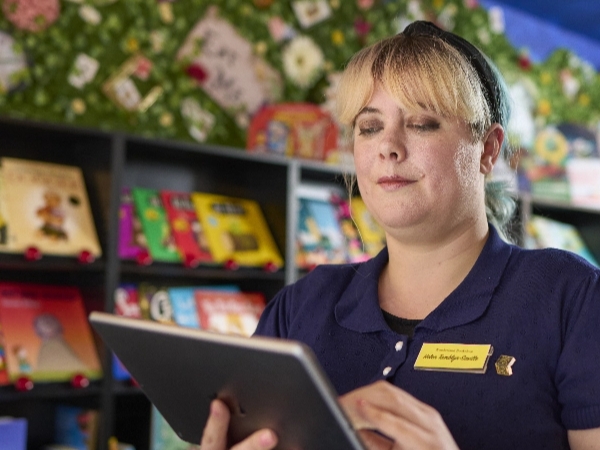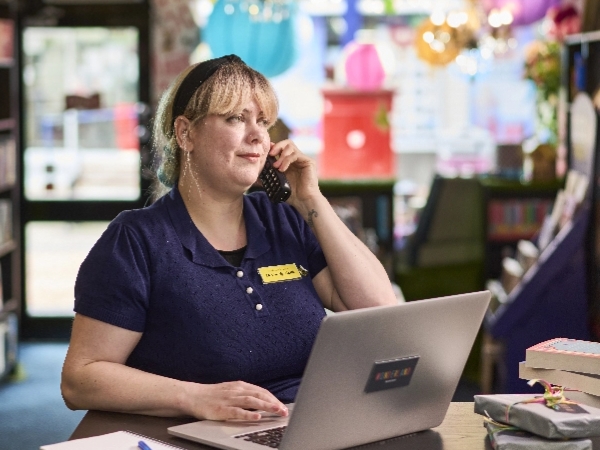And if you’re planning to open up online only for your shop, you’ll find that while they are declining in comparison to the height of the pandemic, online sales still remain firmly above where they were in February 2020.
How are different retail sectors faring in a post-pandemic world?
Whether you’re still looking for your next business idea or you already have a side-hustle successful enough to let you run a shop full-time, it’s important to understand how your industry is doing and whether or not now is a stable time to invest in a digital or physical retail space.
According to Retail Economics’ 2022 Outlook for the Retail Industry, here’s the sales growth that they’re expecting for various sectors in 2022:

Apparel
2021 Actual: 29.1%
2022 Forecast: 3.4%

Electricals
2021 Actual: 2.1%
2022 Forecast: -4.1%

Home, Furniture & Flooring
2021 Actual: 15.6%
2022 Forecast: 2.8%

DIY & Gardening
2021 Actual: 13.7%
2022 Forecast: -0.4%

Health & Beauty
2021 Actual: 9.7%
2022 Forecast: 7.8%
*Data from Retail Economics 2022 Outlook for the Retail Industry
Online retailer vs high street
Luckily, with the ease of getting your business online nowadays, there doesn’t really need to be a competition between online and high street retailing. Each has their own distinct advantage, but both in tandem can often achieve the best results. During the pandemic, online sales surged while getting to physical stores was restricted or felt unsafe. We’ll take a look at more of the differences between online and physical stores:

Benefits of online stores:
- Easier to attract new customers looking specifically for your products via search engines.
- It’s open all hours of the day, but you don’t need to be tied to a specific location.
- If you’re online only, you won’t be paying for a physical store front’s rent, furniture, electricity and other costs.
- You can have a wide variety of stock and not worry about it all fitting beautifully into a finite physical space.

Benefits of high street stores:
- You get to interact with your customers and get to know them personally.
- Can be easier to upsell in person by prompting customers to try a product. • Customers get to see and engage with the product in person. This can be helpful for showcasing high quality products.
- It is easier to respond to consumer queries or concerns in real time and assist in making the sale.
- You have full quality control as the product is with you until the customer takes it. There’s not a risk of customers getting a damaged product or it getting lost in transit.

Benefits of having both:
- They can push traffic to each other. Someone who sees your products in person but isn’t ready to buy may find you online later. Conversely, someone who saw your products online may want to see them in person and head into your store.
- You can implement click and collect style processes to make it easier for customers that use a blend of online and in-person shopping.
- Allows people to research a product online and in their own time before deciding to buy it in store.
Startup costs & equipment

Opening a shop can require a lot of equipment and suppliers. While the start up costs will vary widely depending on the size of your shop and the industry you are in, we’ll take a look at a few expenses that you may want to consider when becoming a store owner.

In a post-pandemic world, having the right payment options is more important than ever as the expectation is now that card payments – particularly contactless payments – be available for consumers. Consider the following when choosing a payment processing platform:
- Can the system accommodate cash, chip and pin, contactless and mobile payments? Are there any additional rates and fees associated with certain payment types?
- How secure is the system? Can you feel comfortable that customer data is safe?
- How quickly does the system work – both for processing payments and for depositing the money into your accounts?
And that’s just the payment aspect. Point of sale systems today can do so much more than just take payments. Depending on what you’re looking for your payment system to do, the costs will be different so be sure to shop around and find the best solution for you. Here’s a few ideas of what you may want your PoS to do:
- Update your stock for both online and in-store systems when an item is purchased
- Data analytics that help you with forecasting how much stock you need and what’s performing well with customers
- Notifications when stock is running low for a certain product so that you can reorder in time
- Ability to be upgraded in the future to add-on new functions that you don’t need now but may want later.

The ambience of a store can be a key part of making it attractive to customers. In fact, there’s even a case for decorations being an allowable expense for retailers as the look and feel of a store is so integral to its success. You can hire a company to set up your display and design, even making bespoke fittings for your space, however this can be quite expensive. Doing it yourself and buying second-hand furniture can work just as well if you’re looking to save a bit.
Think about how you want products laid out – do you need tables, shelves or baskets to do it justice? Do you want a seating area? Do you need a space for people to try products on? Consider all this when creating a budget for opening your store.

As an ongoing cost, you’ll need to consider the gas, electricity, wi-fi, phone bills, music licensing, insurance and more.
According to Money Supermarket, the average microbusiness will spend up to £820 on gas and £2,200 on electric per year while the average small business will range around £1,450 on gas and £3,660 on electric. With the new rise in energy price caps, it is possible these will have increased as well. You’ll want to take all of these bills into account when deciding how much rent you can afford and how to price your items.
While going online only will cut out some of these costs, you’ll still have a good number of regular fees such as wifi, insurance, HTTPS security certificates and your website domain fees.

When opening your store, you’ll need to initially lay out the money to have stock in the store. While you’re hoping to sell this and make back that initial outlay and then some, you will need to budget appropriately as some stock may be with you for a few months before it is sold. You should also consider the costs of storing the stock. Whether you have it all on display in your storefront or don’t have a storefront at all, it's important to think about where your stock will be kept and how it will be organised.

Depending on how your store runs and how often it is open, you may want to have some employees to help you with day to day operations. Costs for employees can include their wages, benefits, training, and employer’s liability insurance to name a few aspects.

Having some marketing materials will be really helpful when getting started and depending on your skills, you may need to hire a graphic designer to help with some parts. You might want to have a logo, some business cards, a website, social media accounts and perhaps a digital ad or two ready to go when you’re starting out. While marketing can be an extra initial cost, making sure people know about your business can ensure you start strong.

If you are planning to send your products to customers at all, you’ll want to consider delivery costs and how to get that service set up. You may be able to get different deals depending on who you use, what you’re sending and how often you’re sending so be sure to explore all your options. A few of the more well-known choices are Royal Mail, DPD, and Yodel – but you may find that other companies work better for meeting the needs of you and your customer.
What skills and qualifications do you need?

As with any entrepreneurial endeavor, you’ll want to have the basic business skills to manage your shop, but you’ll also want skills and experience relevant to your industry. While there’s no qualifications needed to open a retail shop, you will definitely want to familiarize yourself with accounting and finance principles, even if you intend to outsource some of that work to another person.
Other skills and knowledge that may help you succeed are:
- Customer service and small talk skills
- Negotiation skills when dealing with suppliers and partners
- Self-motivation as there’s no one pushing you to do the work
- Ability to upsell products
- Design sense for making good product displays
- Organisational skills for staying on top of invoices, product inventory and other admin
Steps for getting started
If you’ve got the perfect side hustle idea and are ready to open a shop and become a retailer, we’ve highlighted a few key steps to help you get started.
- Do your market research. You’ll need to fully understand your customer’s expectations and the trends in your sector. This knowledge will help shape decisions such as your location, décor, prices, and necessary equipment.
- Get the details down. Formalising all your ideas into a business plan is a great way to make sure you stay on track and will help set out your strategy and objectives, then break them down into concrete tasks and clear goals.
- Source the right suppliers. It will take some time to research suppliers and negotiate the best terms for you. With net zero goals for business on the horizon, you may also want to look into sustainable supply chains that give you a competitive advantage.
- Open a business account. If you’re a brand new retailer you won’t have much business history to demonstrate, so it’s worth looking into business credit scores and how to start establishing yours. Having a good business credit score can help you negotiate better rates with suppliers in the future.
- Get your name out there. There are many different facets to this such as building your network with other local business, beginning your marketing activities and, if you’re a limited company, getting your business registered with the Companies House.
Laws and regulations to be aware of
There are quite a few regulations that shop owners need to follow when selling their products. If you sell to consumer, then one of the main pieces of legislation you’ll need to comply with is the Consumer Rights Act (2015). These rules say that all goods, whether physical or digital, must be fit for purpose, as described and of satisfactory quality.
Other rules you might want to watch out for are:
VAT regulations for shops
If your business has a taxable turnover of £85,000 or more over a consecutive 12-month period, you’ll need to register for VAT.
Health and safety regulations
You should carry out a risk assessment so that you can identify and minimise any potential hazards in your shop. Depending on the goods you sell, there may be additional requirements. The Health and Safety Executive are a good place to look for guidance.
Music licences If you intend to play background music in your store to create an ambience, then you’ll need a licence in order to do so.
Street display rights
If you want a small seated area or even just a sign on the street outside of your shop, you’ll have to get a licence. Fines for this can be as steep at £2,500 so you definitely want to get the right paperwork in place!
Making sure you’re insured
It’s crucial to invest in insurance coverage for your retail store. Common coverage includes Employer’s Liability, Public Liability and Business Insurance. Make sure you are legally compliant when it comes to the types of insurance you are required to have by law as well as fully covered for other aspects of your business e.g., insurance of glass frontages etc.
There may be more licences for you depending on what your product is and all of these rules are subject to change, so you’ll need to stay on top of any changes to the regulations. To double check you've got the correct business licences in place to keep your business operating legally and safely, pay a visit to the Government's licence finder for added peace of mind.
Register your business – sole trader vs limited company

Sole-trader/self-employed
A person who’s the only owner of their business. There’s no legal separation between you as the business owner and the business itself.

Limited company
A business which is a distinct legal entity from the business owner, formed whether you’re a one-person operation or have a few staff.
Get a deep dive into what this could mean for your business with AXA’s guide to different company structures: Sole trader or limited company?
READ THE GUIDEMarketing your business
If you’ve done your audience research as suggested above, you may already have a good idea of how to reach your ideal customer – and that’s great. If you’re still struggling to think of a marketing strategy, take a look at our guide to writing a marketing plan to help you get the details down. If you need some inspiration, here’s a few ideas for marketing a retail shop:
Go digital
Starting a website, using social media, even having your business listed on Google are all ways to help customer find your shop.
Advertise
Both online and in print. Put some spend behind ads on social platforms, but also get flyers up in local pubs and cafes where possible.
Pop up events
Keep an eye out for small markets and fairs where you could have a pop-up stall once in a while. This is a great way to show your wares to people who might not normally pass by your store or see your products.
Host events
At your own shop such as launches for new products or lines.
As you can see, whether your online or on the high street, there’s a lot to consider for opening up your own retail shop. If you’re feeling nervous about taking the leap and becoming your own boss, that’s totally natural. Our guide to the ups and downs of starting a business can help with those initial hurdles and making sure you have the right insurance can help give you peace of mind.
Ready to become a shop owner?
Starting your own business is something worth protecting. Get started today with AXA’s business insurance for both online and high street retailers.
All links are checked and valid at time of publishing, 05 August 2022.
